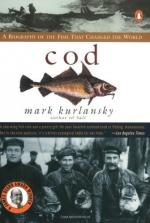
|
| Name: _________________________ | Period: ___________________ |
This test consists of 15 multiple choice questions and 5 short answer questions.
Multiple Choice Questions
1. What were sail-powered draggers called?
(a) Smacks.
(b) Wingets.
(c) Widgets.
(d) Dibs.
2. Dorymen's wives made sails for them sewn from _____.
(a) Flour sacks.
(b) Old sheets.
(c) Towels.
(d) Old clothes.
3. Equipment that waits for the fish is called _____.
(a) Comstocks.
(b) Passive gear.
(c) Dead netting.
(d) Diggers.
4. What were thick rubber gloves with cotton lining that fishermen wore called?
(a) Nippers.
(b) Skimmers.
(c) Stiffs.
(d) Mitts.
5. Who was Canada's biggest competitor in the cod market in the 19th century?
(a) Britain.
(b) Iceland.
(c) Sweden.
(d) Norway.
6. Which boat was invented on the Pacific to deal with rough seas and haul in bigger catches?
(a) The stern trawler.
(b) The three-mast schooner.
(c) The clipper.
(d) The otter trawler.
7. What fish was pointed out by the European Economic Community to be abundant off the coast of Scotland?
(a) Walleye.
(b) Herring.
(c) Blue whiting.
(d) Haddock.
8. Most Icelandic towns have a population under _____ people.
(a) 10,000.
(b) 50.
(c) 100.
(d) 2,000.
9. Watertight ship holds with holes for circulating seawater to keep fish alive were called _____.
(a) Live cages.
(b) Cod keepers.
(c) Keeper holds.
(d) Wet wells.
10. Iceland is encrusted with _____.
(a) Lava.
(b) Barnacles.
(c) Dead sea creatures.
(d) Sand.
11. Which rich fishing region was considered the laboratory for cod fishing innovation?
(a) The North Sea.
(b) The Georges Bank.
(c) The Grand Banks.
(d) The Icelandic coast.
12. The 19th-century debate over longlining seemed to have been fueled by _____.
(a) Conservation.
(b) Fatalism.
(c) Colonialism.
(d) Nationalism.
13. Today, fish sticks are usually _____.
(a) Ling cod.
(b) Haddock.
(c) Pacific pollock.
(d) Pacific cod.
14. Which international organization met in 1973 to expand ocean sovereignty?
(a) NATO.
(b) The UN Seabed Committee.
(c) The Northern Seas Alliance.
(d) International Fisheries Council.
15. What company did Clarence Birdseye found in Gloucester?
(a) General Seafoods Company.
(b) Gorton's Seafood Company.
(c) Ocean Foods.
(d) Harbor Food Processing.
Short Answer Questions
1. What is considered a bread substitute in Iceland?
2. What is a lost net that can continue to fish for as long as five years called?
3. What Nova Scotia fish product was heavily salted on schooners, then dried on flakes along a rocky coastline?
4. What was invented in the mid-19th century that was slow to catch on in the fishing industry?
5. Who were infamous on the Grand Banks for the harshness of their working conditions?
|
This section contains 375 words (approx. 2 pages at 300 words per page) |

|




